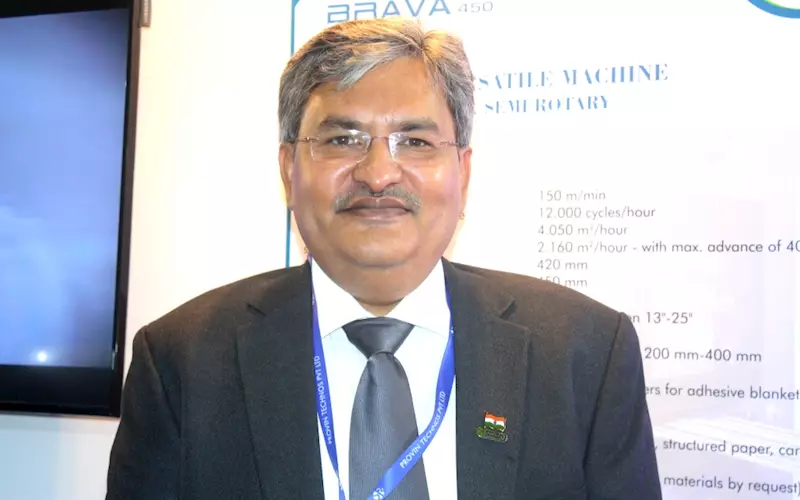Exhibitors Speak: Vinay Kaushal, director, Provin Technos
In more or less two years since Provin Technos started representing the merged Ryobi-Mitsubishi, now known as RMGT, the Delhi-based company has turned it into a sought-after brand, that too in a market where experts are writing off offset. At Labelexpo India 2016, the company is highlighting another of its key product, the Rotatek Brava 350/450. Would it be able to replay its success with the Brava, which, Vinay Kaushal, director, Provin Technos, claims this is the only offset machine available
19 Nov 2016 | By PrintWeek India
Labels are getting more complex and innovation is a major driver. You agree?
Yes. Value addition is the buzzword in printing, and label is no different. Different needs like security aspects are making them complex. Innovation is a must for value addition. Adding value means innovative labels. Label is the silent sales agent and it has to be attractive. On top of it, you can add security features to fight anti-counterfeiting. Basically, we will have to enhance the value and enhancement abilities of the label in all aspects of printing.
A hybrid printing machine, in which you use all things, such as inline, flexo, offset, digital, and screen is a value-addition. This helps a printer manufacture better labels. Now, we have flatbed screen in inline machines, where most of the operations are inline. You have one coater in the beginning, then another coater, hot and cold foil, screen, perforation, everything.
Five years ago, if one had to buy a narrow-web flexo press, one looked at number of colours and a couple of finishing additions. Today, the equation has evolved.
Again this is related to value-addition. Many people have stated doing this. Half of them know what they are going to do with the machine. With the changing market, requirements have change. The Indian market is evolving into a higher category. If you talk about five years ago, machines were very simple but not now. At least eight-colour high configuration machines are coming into the market. We are behind the higher segment.
More and more flexo vendors are offering hybrid presses. Has it become mandatory to have a hybrid press to compete in Indian label market?
Not yet. There is some more time before hybrid presses will be a must in the market. Hybrid machines are in the market for the last 10 years. For example, Kolkata-based printers like Eagle Press and Secure Press have flexo, offset and digital all in one machine.
All efforts by flexo manufacturers are put in making short-runs economical. Has the Indian label market matured enough to really worry about short-runs?
For the Indian market, the next step is to look at short-run and value-addition though the market is not yet ready to change due to machine costing. We have to reach to that level. There is digital, but digital is not affordable to many. In India, we are talking about 2.5 lakh printers, 25% of which cannot afford the technology we are talking about. For the Indian market, the next step is to look at short-run and value-addition though market is not yet ready to change due to the machine costing.
In the last three years, flexo presses have upped one level of makeready automation and faster changeovers. Is this to fight the competition from digital?
No. Digital is a different market altogether. Becoming more and more efficient and productive with lower makeready is a market-driven demand. From the manufacturers’ perspective, it’s an ongoing process of product development and upgradation.
There are flexo press which can be set up in less than 10 minutes and offers pre-registration on the print stations together with automatic registration. Do you have something similar in your bag of products?
Yes. We have Smartflex which has all these features. Several technologies in one machine is very much possible. Rotatek, which we are showcasing in Labelexpo India 2016, is in security printing for a long time. Considering the demand in India, the company has come up with flexo presses with smallest web path and they are completely shaftless,
Does increased automation mean high efficiency?
Yes. Automation helps printers improve on productivity and wastage reduction. This, in turn, adds to a better bottom line. Auxiliaries are not a constraint.
Another trend is wider versions of narrow web flexo press, aimed at opportunities in short-run flexible packaging and folding carton. Are we redefining the boundaries of a label printer?
The Indian market is not yet on this level. For folding carton, combi-presses are the need of the hour, but the market is not yet ready with the pricing of those big configurations. We have combi-press with width of 520/680 and higher with all possible inline configurations like die-cutting and folder-gluer inline with very high speed. Ultimately, the market will evolve to these configurations.
Among the 10-12 digital label printing machines installed in India, barring three or four players, others are still struggling. What’s the reason?
Digital is a different market segment, be it sheetfed or narrow-web. Understanding market dynamics is very important.
On the pre-press front, the dots continue to get finer and flexo print sharper. There was Esko’s Full HD and in the last couple of years, Kodak’s Flexcel NX has gained popularity in India. What’s next?
We will see in a short time.














 See All
See All